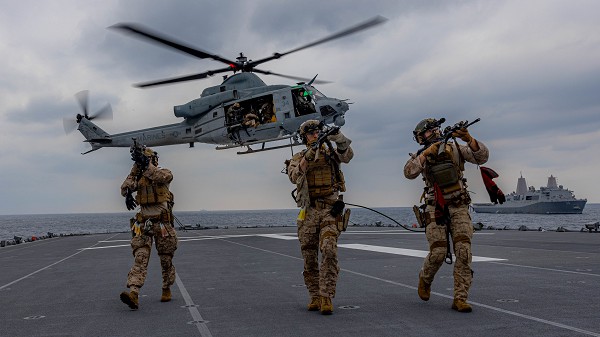
Pacific Ocean. (March 4, 2023): In this photo by Sergeant Marcos A. Alvarado, U.S. Marines with the maritime raid force 31st Marine Expeditionary Unit conduct a search during a visit, board, search, and seizure (VBSS) exercise aboard the tank landing ship JS Osumi during Exercise Iron Fist 23.
Iron Fist 23 provided an opportunity for the USS America Amphibious Ready Group and the Japanese Maritime Self Defense Force to work together in combined counter-piracy operations at sea. The 31ST Marine Expeditionary Unit (MEU) serves as America’s forward deployed, quick response force capable of responding immediately to crises around the world. Commanded by a Marine colonel, the 31st MEU is comprised of approximately 2,200 Marines and Sailors embarked aboard three or four amphibious ships.
Iron Fist 23 is an annual field training exercise designed to increase interoperability and strengthen the relationship between the Marine Corps, Navy, and the Japanese Self Defense Force. This year’s exercise simulated an island seizure involving airborne and battalion landing teams working with their Japanese counterparts.
Visit, board, search, and seizure exercises practice maritime boardings of suspect vessels at sea and is one of the more dangerous peacetime missions for the Navy. These boarding teams capture enemy vessels, combat terrorism, stop piracy, and prevent smuggling of contraband or human traffic. These highly trained professionals undergo eight weeks of training in close quarter battle, shooting, rappelling, and search and seizure procedures. Marines are trained to fast rope from helicopters onto potentially hostile vessels and use their tactical skills to subdue and seize the ship and its crew. As one can imagine, the school’s dropout rate is unusually high, around 30% fail to qualify.
U.S. Navy VBSS teams are generally armed with M4 carbines, Mossberg 500 shotguns, and Beretta M9 pistols. Raiders wear Kevlar body armor with ballistic plate inserts and a buoyant tactical vest that doubles as a life preserver. The majority of U.S. naval ships deploying with VBSS teams are smaller, such as destroyers, cruisers and these teams are often used to combat illegal narcotics, arms trafficking, and piracy.
The Japan Maritime Self-Defense Force is the naval warfare branch of the Japanese Self Defense Force and has a fleet of 154 ships, 346 aircraft, and 50,800 personnel.


